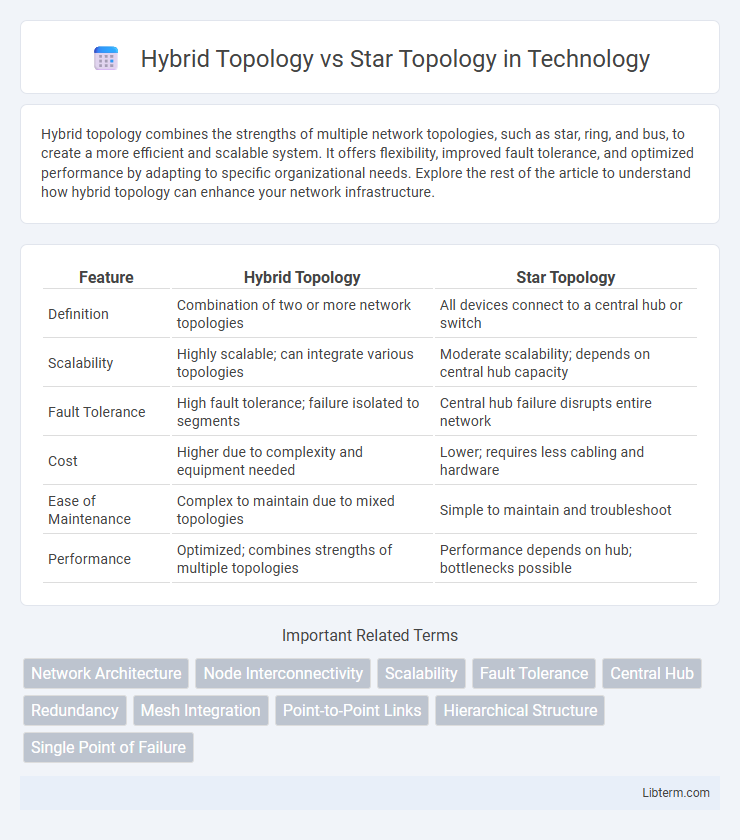Hybrid topology combines the strengths of multiple network topologies, such as star, ring, and bus, to create a more efficient and scalable system. It offers flexibility, improved fault tolerance, and optimized performance by adapting to specific organizational needs. Explore the rest of the article to understand how hybrid topology can enhance your network infrastructure.
Table of Comparison
| Feature | Hybrid Topology | Star Topology |
|---|---|---|
| Definition | Combination of two or more network topologies | All devices connect to a central hub or switch |
| Scalability | Highly scalable; can integrate various topologies | Moderate scalability; depends on central hub capacity |
| Fault Tolerance | High fault tolerance; failure isolated to segments | Central hub failure disrupts entire network |
| Cost | Higher due to complexity and equipment needed | Lower; requires less cabling and hardware |
| Ease of Maintenance | Complex to maintain due to mixed topologies | Simple to maintain and troubleshoot |
| Performance | Optimized; combines strengths of multiple topologies | Performance depends on hub; bottlenecks possible |
Introduction to Network Topologies
Hybrid topology combines characteristics of multiple network topologies, such as star, bus, and ring, to create a flexible and scalable network structure tailored to specific organizational needs. Star topology features a central hub or switch connecting all nodes, simplifying fault detection and management while ensuring efficient data transmission. Understanding the differences between hybrid and star topologies is crucial for optimizing network performance, scalability, and fault tolerance in various IT environments.
What is Star Topology?
Star topology is a network configuration where each device connects directly to a central hub or switch, enabling efficient data transmission and easy fault isolation. It offers high performance due to dedicated communication links and simplifies network management by localizing potential points of failure to the central node. Unlike hybrid topology, which combines multiple topologies, star topology maintains uniformity with its straightforward, centralized design.
What is Hybrid Topology?
Hybrid topology combines multiple network topologies such as star, bus, and ring into a single, cohesive structure to optimize performance and scalability. It leverages the strengths of each individual topology, enhancing fault tolerance and flexibility in complex networking environments. Hybrid topologies are commonly used in large organizations to accommodate diverse networking requirements while maintaining efficient data flow and robust connectivity.
Key Features of Star Topology
Star topology features a central hub or switch to which all nodes connect individually, ensuring easy network management and simplified fault isolation. Its key characteristics include high reliability due to the independence of each connection, straightforward scalability by adding or removing devices without affecting the entire network, and improved performance with reduced data collisions compared to bus or ring topologies. This structure supports efficient troubleshooting and minimal downtime, making it ideal for small to medium-sized networks requiring centralized control.
Key Features of Hybrid Topology
Hybrid topology combines the strengths of star, bus, ring, and mesh topologies, offering high flexibility and scalability for complex networks. It supports multiple network architectures simultaneously, enhancing fault tolerance and minimizing downtime through segment isolation. This topology efficiently manages large volumes of data traffic, making it ideal for enterprise environments requiring robust and adaptable network designs.
Advantages of Star Topology
Star topology offers significant advantages including simplified network management and easy fault detection as each device connects independently to a central hub, minimizing network disruption. It enhances performance by reducing data collisions through dedicated point-to-point connections, ensuring efficient communication. Scalability is straightforward, allowing new devices to join or leave without impacting the overall network stability, making star topology ideal for both small and large networks.
Advantages of Hybrid Topology
Hybrid topology combines the strengths of star and bus topologies, offering enhanced flexibility and scalability for complex network designs. It allows for easier troubleshooting and fault isolation since each segment can operate independently, minimizing network downtime. This topology supports diverse network devices and media types, optimizing performance and reliability across varied environments.
Drawbacks of Star Topology
Star topology faces major drawbacks, including a single point of failure where the central hub or switch's malfunction disrupts the entire network. Scalability is limited by the hub's number of ports, restricting network expansion without additional hardware. High dependency on central devices increases maintenance costs and network downtime risks compared to hybrid topology's flexible combination of multiple topologies.
Drawbacks of Hybrid Topology
Hybrid topology combines multiple network topologies, increasing complexity and deployment costs compared to simpler structures like star topology. Troubleshooting and maintenance in hybrid topology require specialized skills due to the integration of diverse network types, leading to longer resolution times. Scalability can be limited as the complexity of managing various interconnected topologies grows, potentially impacting overall network performance.
Hybrid Topology vs Star Topology: Comparative Analysis
Hybrid topology combines the characteristics of star, bus, and ring topologies, offering high flexibility and scalability compared to star topology, which connects all nodes directly to a central hub. Hybrid topology excels in fault tolerance by isolating network segments, whereas star topology's dependency on a single central hub increases vulnerability to failures. Performance in hybrid topology tends to be more efficient in large, complex networks, while star topology remains simpler and easier to manage for smaller networks.
Hybrid Topology Infographic

 libterm.com
libterm.com